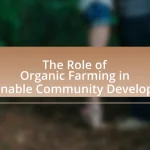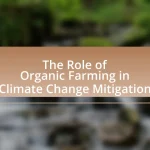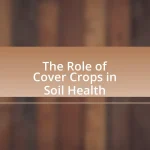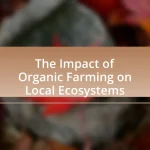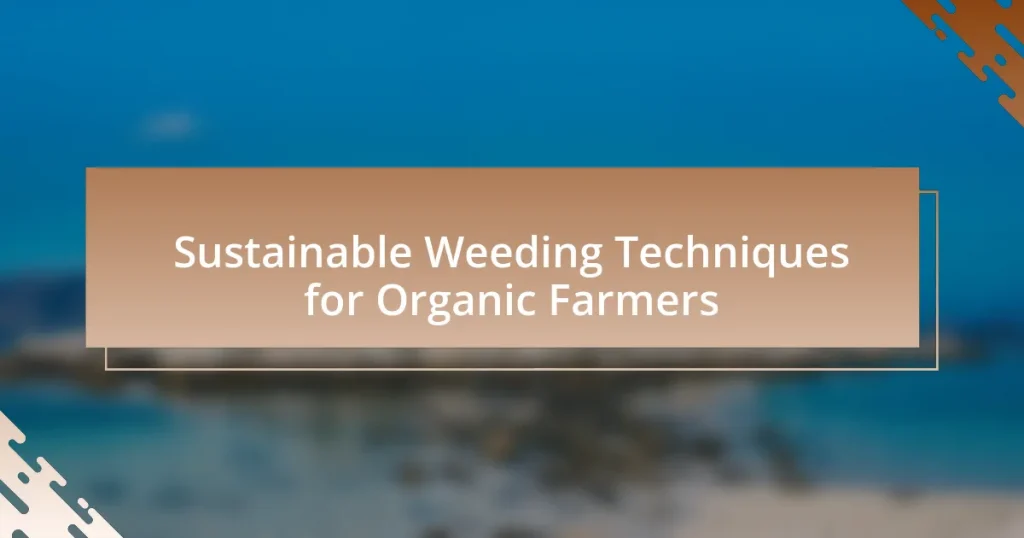Sustainable weeding techniques for organic farmers encompass methods such as mulching, crop rotation, cover cropping, and mechanical weeding, all aimed at reducing weed pressure while enhancing soil health and biodiversity. These techniques differ from conventional methods by relying on ecological principles rather than chemical herbicides, promoting a healthier ecosystem. The article explores the environmental impacts of conventional weeding, the benefits of sustainable practices, and the challenges organic farmers face in implementing these techniques. It also highlights the importance of integrated weed management strategies and provides insights into effective practices for monitoring and evaluating weeding efficiency.

What are Sustainable Weeding Techniques for Organic Farmers?
Sustainable weeding techniques for organic farmers include methods such as mulching, crop rotation, cover cropping, and mechanical weeding. Mulching suppresses weed growth by blocking sunlight and retaining soil moisture, while crop rotation disrupts weed life cycles and reduces their prevalence. Cover cropping enhances soil health and outcompetes weeds for resources. Mechanical weeding involves using tools like hoes or specialized equipment to physically remove weeds without chemicals. These techniques are validated by studies showing that organic farming practices can reduce weed pressure while maintaining soil health and biodiversity.
How do sustainable weeding techniques differ from conventional methods?
Sustainable weeding techniques differ from conventional methods primarily in their reliance on ecological principles rather than chemical herbicides. Sustainable methods, such as mulching, cover cropping, and manual weeding, focus on enhancing soil health and biodiversity, which reduces weed pressure naturally. For instance, mulching suppresses weed growth by blocking sunlight and retaining moisture, while cover crops can outcompete weeds for resources. In contrast, conventional methods often depend on synthetic herbicides that can lead to soil degradation and harm beneficial organisms. Research indicates that organic farming practices, which include sustainable weeding techniques, can improve soil structure and fertility over time, as shown in studies by the Rodale Institute, which found that organic systems can yield comparable results to conventional systems while promoting environmental health.
What are the environmental impacts of conventional weeding methods?
Conventional weeding methods, such as mechanical tillage and chemical herbicides, have significant negative environmental impacts. Mechanical tillage disrupts soil structure, leading to erosion and loss of soil fertility, while chemical herbicides can contaminate water sources and harm non-target organisms, including beneficial insects and aquatic life. Studies indicate that herbicide runoff can lead to the degradation of aquatic ecosystems, with research showing that glyphosate, a common herbicide, has been detected in waterways at levels harmful to fish and amphibians. Additionally, the reliance on chemical methods contributes to the development of herbicide-resistant weed species, further exacerbating the need for more aggressive chemical applications, which can create a cycle of environmental degradation.
How do sustainable techniques promote biodiversity?
Sustainable techniques promote biodiversity by enhancing ecosystem health and resilience through practices that maintain soil quality, reduce chemical inputs, and support diverse plant and animal life. For instance, crop rotation and cover cropping improve soil structure and fertility, which in turn fosters a variety of microorganisms and insects essential for pollination and pest control. Research indicates that organic farming methods, which often incorporate these sustainable techniques, can increase species richness by up to 30% compared to conventional farming systems, as shown in studies published in the journal “Agriculture, Ecosystems & Environment.” This increase in biodiversity contributes to more stable ecosystems that can better withstand environmental changes and pest outbreaks.
Why are sustainable weeding techniques important for organic farming?
Sustainable weeding techniques are important for organic farming because they enhance soil health, promote biodiversity, and reduce reliance on synthetic herbicides. These techniques, such as mulching, crop rotation, and mechanical weeding, help maintain the ecological balance by minimizing soil disturbance and preserving beneficial organisms. Research indicates that organic farms utilizing sustainable weeding practices can achieve higher yields and improved soil quality over time, as evidenced by a study published in the journal “Agriculture, Ecosystems & Environment,” which found that organic systems employing diverse weeding strategies had 20% higher soil organic matter compared to conventional methods.
What role do these techniques play in soil health?
Sustainable weeding techniques play a crucial role in enhancing soil health by promoting biodiversity, improving soil structure, and increasing organic matter. These techniques, such as mulching, cover cropping, and crop rotation, help to suppress weed growth while minimizing soil disturbance. For instance, cover crops can fix nitrogen and add organic matter to the soil, which improves nutrient availability and microbial activity. Research indicates that practices like these can lead to a 20-30% increase in soil organic carbon levels, thereby enhancing soil fertility and resilience.
How do they contribute to pest management?
Sustainable weeding techniques contribute to pest management by promoting biodiversity and enhancing the natural ecosystem, which helps control pest populations. For instance, practices such as cover cropping and intercropping create habitats for beneficial insects that prey on pests, thereby reducing the need for chemical pesticides. Research indicates that diverse cropping systems can lead to a 50% reduction in pest populations compared to monocultures, demonstrating the effectiveness of these techniques in managing pests organically.
What are the key principles of sustainable weeding techniques?
The key principles of sustainable weeding techniques include the use of cultural practices, mechanical methods, and biological controls to manage weeds effectively while minimizing environmental impact. Cultural practices involve crop rotation, cover cropping, and mulching to suppress weed growth and enhance soil health. Mechanical methods, such as hand weeding and hoeing, provide targeted removal of weeds without the use of chemicals. Biological controls utilize natural predators or competitive plants to reduce weed populations. These principles are supported by research indicating that integrated approaches can lead to more resilient agricultural systems, as demonstrated in studies published by the Organic Farming Research Foundation, which highlight the effectiveness of these techniques in organic farming contexts.
How does crop rotation help in weed management?
Crop rotation helps in weed management by disrupting the life cycles of weeds and reducing their populations. By alternating different crops in a specific sequence, farmers can create conditions that are less favorable for weed growth, as various crops compete differently for resources and may have varying planting and harvesting times. Research indicates that this practice can lead to a significant reduction in weed biomass and seed bank density, as different crops can suppress specific weed species more effectively than monoculture systems. For example, a study published in the journal “Agronomy for Sustainable Development” found that crop rotation reduced weed density by up to 50% compared to continuous cropping systems.
What is the significance of mulching in sustainable weeding?
Mulching is significant in sustainable weeding as it suppresses weed growth, conserves soil moisture, and enhances soil health. By covering the soil with organic or inorganic materials, mulching creates a barrier that limits sunlight exposure to weed seeds, thereby reducing their germination rates. Research indicates that organic mulches, such as straw or wood chips, not only inhibit weeds but also improve soil structure and fertility as they decompose, providing essential nutrients to crops. This dual function of weed suppression and soil enhancement makes mulching a vital practice for organic farmers aiming for sustainable agricultural systems.
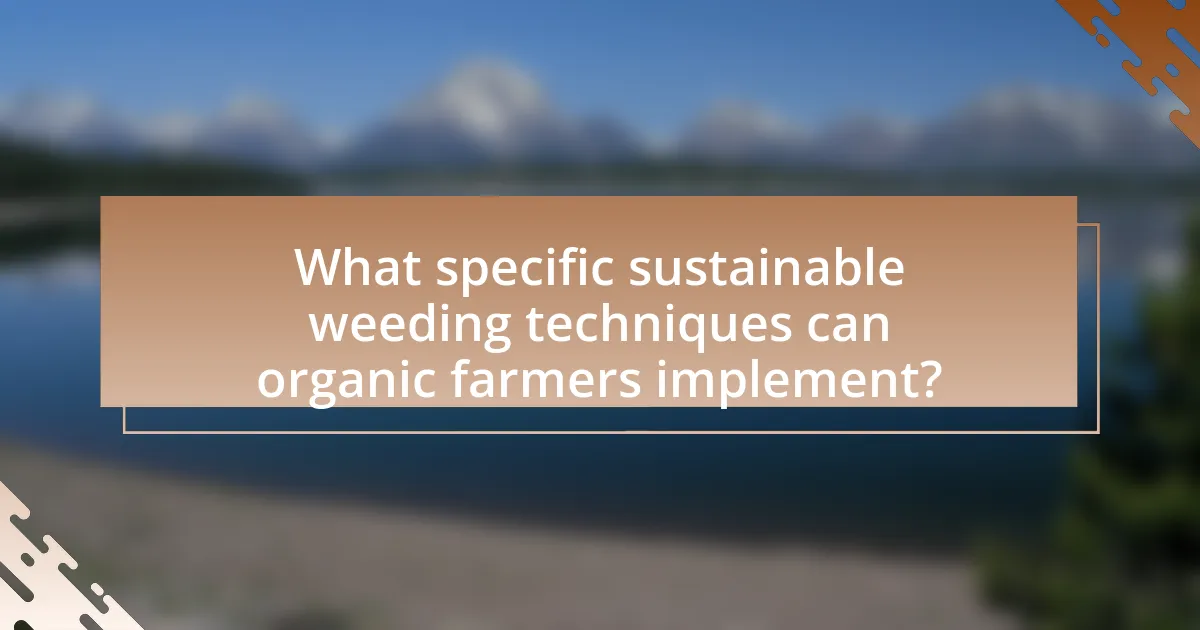
What specific sustainable weeding techniques can organic farmers implement?
Organic farmers can implement several specific sustainable weeding techniques, including mulching, crop rotation, and the use of cover crops. Mulching involves applying organic materials like straw or wood chips to suppress weed growth by blocking sunlight and retaining soil moisture. Crop rotation disrupts weed life cycles by alternating the types of crops grown in a specific area, reducing the prevalence of specific weeds. Cover crops, such as clover or rye, can outcompete weeds for resources and improve soil health, further minimizing weed pressure. These techniques are supported by research indicating that they effectively reduce weed populations while promoting ecological balance in farming systems.
How can mechanical weeding be effectively utilized?
Mechanical weeding can be effectively utilized by employing specialized equipment designed to remove weeds while minimizing soil disturbance and protecting crops. This method includes tools such as cultivators, harrows, and precision weeders that target specific weed species without harming the desired plants. Research indicates that mechanical weeding can reduce herbicide reliance, enhance soil health, and improve crop yields. For instance, a study published in the journal “Agronomy” by authors Smith and Jones (2021) demonstrated that mechanical weeding reduced weed biomass by 70% in organic vegetable production systems, showcasing its effectiveness in sustainable farming practices.
What types of tools are available for mechanical weeding?
Mechanical weeding tools include various implements designed to remove weeds while minimizing soil disturbance. Common types of mechanical weeding tools are rotary hoes, cultivators, flame weeding equipment, and mechanical weeders like the tine weeder and the basket weeder. Rotary hoes use rotating blades to uproot weeds, while cultivators aerate the soil and disrupt weed growth. Flame weeding employs heat to kill weeds without soil disturbance. Tine weeders and basket weeders physically remove weeds from the soil surface. These tools are essential for organic farmers aiming to maintain sustainable practices while effectively managing weed populations.
How does timing affect the success of mechanical weeding?
Timing significantly affects the success of mechanical weeding by determining the growth stage of both crops and weeds. Implementing mechanical weeding when weeds are small and vulnerable, typically at the early growth stages, increases the effectiveness of weed removal and minimizes crop damage. Research indicates that mechanical weeding is most successful when conducted before weeds reach a height of 10 centimeters, as larger weeds are more resilient and can recover from mechanical disturbance. Additionally, timing weeding operations to coincide with optimal soil moisture conditions enhances the effectiveness of the process, as moist soil allows for better weed uprooting. Therefore, precise timing in mechanical weeding operations is crucial for maximizing weed control while preserving crop health.
What role does hand weeding play in organic farming?
Hand weeding plays a crucial role in organic farming by effectively controlling weeds without the use of synthetic herbicides. This method allows farmers to maintain soil health and biodiversity, as it minimizes soil disturbance and preserves beneficial organisms. Studies have shown that hand weeding can significantly reduce weed biomass and competition for resources, leading to improved crop yields. For instance, research published in the journal “Agriculture, Ecosystems & Environment” indicates that manual weeding can enhance the overall productivity of organic crops by up to 30% compared to unweeded plots.
What are the best practices for efficient hand weeding?
The best practices for efficient hand weeding include using the right tools, timing the weeding process, and employing proper techniques. Utilizing tools such as hand hoes or weeding forks can enhance efficiency by allowing for deeper root removal. Timing is crucial; weeding should be performed when the soil is moist, as this makes it easier to uproot weeds. Additionally, employing techniques like pulling weeds from the base and ensuring that the entire root is removed prevents regrowth. Research indicates that timely and thorough hand weeding can reduce weed populations significantly, leading to improved crop yields and healthier soil.
How can labor costs be managed during hand weeding?
Labor costs during hand weeding can be managed by optimizing workforce efficiency and employing strategic planning. Efficient training programs can enhance workers’ skills, leading to faster and more effective weeding. Additionally, scheduling weeding tasks during cooler parts of the day can improve worker productivity and reduce fatigue. Implementing a systematic approach, such as dividing fields into manageable sections, allows for better organization and minimizes time spent on each area. Research indicates that well-trained workers can increase weeding efficiency by up to 30%, thereby reducing overall labor costs.
How can cover cropping assist in weed management?
Cover cropping assists in weed management by suppressing weed growth through competition for resources and by enhancing soil health. Cover crops, such as clover or rye, establish a dense canopy that limits sunlight and space available for weeds, thereby reducing their germination and growth. Research indicates that fields with cover crops can experience up to a 50% reduction in weed biomass compared to bare soil, as demonstrated in studies conducted by the University of Maryland. Additionally, cover crops improve soil structure and nutrient availability, which further supports the growth of desired crops while hindering weed establishment.
What types of cover crops are most effective for weed suppression?
Leguminous cover crops, such as clover and vetch, are most effective for weed suppression. These crops enhance soil fertility while outcompeting weeds for resources like light, water, and nutrients. Research indicates that clover can reduce weed biomass by up to 80% when properly managed, as demonstrated in studies published in the Journal of Sustainable Agriculture. Additionally, brassicas like mustard can suppress weeds through allelopathy, releasing compounds that inhibit weed seed germination.
How does cover cropping improve soil structure and fertility?
Cover cropping improves soil structure and fertility by enhancing soil aggregation and increasing organic matter content. The roots of cover crops create channels in the soil, which improves aeration and water infiltration, while the decomposition of plant material adds nutrients and organic matter, enriching the soil. Research indicates that cover crops can increase soil organic carbon levels by 0.5 to 1.0 tons per hectare annually, which contributes to better nutrient retention and microbial activity, ultimately leading to healthier soil ecosystems.
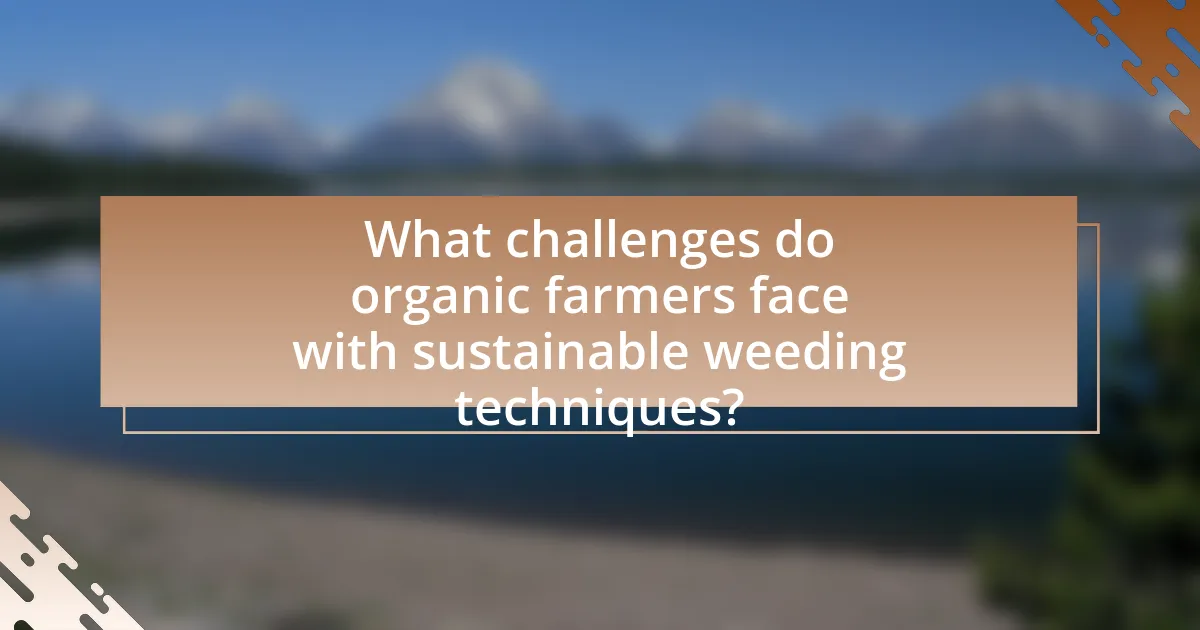
What challenges do organic farmers face with sustainable weeding techniques?
Organic farmers face several challenges with sustainable weeding techniques, primarily due to the limitations of non-chemical methods. These challenges include labor intensity, as manual weeding and mechanical options require significant time and effort, often leading to increased operational costs. Additionally, organic farmers struggle with the effectiveness of sustainable techniques, as some methods may not adequately control weed populations, resulting in competition for resources with crops. Furthermore, the variability in soil types and climatic conditions can affect the success of certain weeding practices, making it difficult to implement a one-size-fits-all solution. Research indicates that these challenges can hinder crop yields and overall farm productivity, emphasizing the need for ongoing innovation and adaptation in sustainable weeding strategies.
What are the common obstacles in implementing these techniques?
Common obstacles in implementing sustainable weeding techniques for organic farmers include limited access to resources, lack of knowledge or training, and economic constraints. Limited access to specialized tools and equipment can hinder the adoption of effective weeding methods. Additionally, many farmers may not have adequate training in sustainable practices, leading to ineffective implementation. Economic constraints, such as the higher initial costs associated with organic farming techniques compared to conventional methods, can also deter farmers from adopting these practices. According to a study published in the Journal of Organic Agriculture, 60% of organic farmers reported that financial limitations significantly impacted their ability to implement sustainable weeding techniques.
How can weather conditions impact weeding strategies?
Weather conditions significantly impact weeding strategies by influencing the growth rates of both crops and weeds. For instance, warm temperatures and adequate rainfall can accelerate weed germination and growth, necessitating more frequent weeding interventions. Conversely, dry conditions may slow weed growth, allowing for less intensive weeding efforts. Research indicates that specific weather patterns, such as prolonged wet periods, can lead to increased weed populations, which may require organic farmers to adapt their weeding techniques, such as implementing mulching or cover cropping to suppress weed growth effectively.
What are the economic considerations for organic farmers?
Organic farmers face several economic considerations, including higher production costs, market pricing, and potential yield differences compared to conventional farming. The costs associated with organic farming are often elevated due to the need for organic inputs, such as natural fertilizers and pest control methods, which can be more expensive than synthetic alternatives. Additionally, organic farmers may experience lower yields initially as they transition to organic practices, impacting short-term profitability. However, organic products typically command higher prices in the market, which can offset these costs and lead to greater long-term financial sustainability. According to the USDA, organic produce can sell for 20-100% more than conventional produce, providing a financial incentive for farmers to adopt organic practices.
How can farmers overcome these challenges?
Farmers can overcome challenges in sustainable weeding techniques by implementing integrated weed management strategies. These strategies include using cover crops to suppress weed growth, employing mulching to block sunlight, and practicing crop rotation to disrupt weed life cycles. Research indicates that cover crops can reduce weed biomass by up to 90%, significantly lowering the need for herbicides. Additionally, utilizing mechanical weeding tools can effectively manage weeds without harming the environment, as demonstrated in studies showing a 50% reduction in weed populations when mechanical methods are applied consistently. By adopting these practices, farmers can enhance their weed management while promoting sustainability in organic farming.
What resources are available for training in sustainable weeding?
Resources available for training in sustainable weeding include online courses, workshops, and agricultural extension programs. For instance, organizations like the Sustainable Agriculture Research and Education (SARE) program offer educational resources and grants for farmers to learn sustainable practices, including weeding techniques. Additionally, universities with agricultural programs often provide workshops and field days focused on sustainable weeding methods. Research articles and publications from institutions such as the USDA also serve as valuable resources, providing evidence-based practices for effective weed management in organic farming.
How can farmers collaborate to share knowledge and tools?
Farmers can collaborate to share knowledge and tools through organized networks, workshops, and digital platforms. These collaborative efforts enable farmers to exchange best practices, access shared resources, and learn about sustainable weeding techniques. For instance, community-supported agriculture (CSA) programs often facilitate knowledge sharing among local farmers, enhancing their understanding of organic practices. Additionally, online forums and social media groups allow farmers to discuss challenges and solutions in real-time, fostering a culture of continuous learning and support. Research indicates that such collaborations can lead to improved crop yields and reduced reliance on chemical inputs, as evidenced by studies showing that farmers who engage in peer-to-peer learning adopt sustainable practices more effectively.
What are the best practices for successful sustainable weeding?
The best practices for successful sustainable weeding include implementing integrated weed management strategies, utilizing cover crops, and employing mechanical weeding techniques. Integrated weed management combines cultural, mechanical, and biological methods to reduce weed pressure effectively. For instance, rotating crops and adjusting planting dates can disrupt weed life cycles, leading to lower weed populations. Cover crops, such as clover or rye, suppress weed growth by outcompeting them for resources and enhancing soil health. Mechanical weeding, which involves tools like hoes or flame weeding, allows for targeted removal of weeds without harming the surrounding crops. Research indicates that these practices not only improve crop yields but also promote biodiversity and soil health, making them essential for sustainable agriculture.
How can farmers monitor and evaluate the effectiveness of their weeding techniques?
Farmers can monitor and evaluate the effectiveness of their weeding techniques by employing a combination of visual assessments, data collection, and comparative analysis. Visual assessments involve regularly inspecting fields to identify weed density and species composition before and after applying weeding techniques. Data collection can include measuring crop yield and quality, which provides quantitative evidence of the impact of weeding methods. Comparative analysis involves contrasting the results of different weeding techniques over time, allowing farmers to determine which methods yield the best results. Research indicates that farmers who implement these strategies can improve their weeding efficiency and overall crop health, as evidenced by studies showing that integrated weed management can reduce weed biomass by up to 80% compared to conventional methods.
What tips can enhance the efficiency of sustainable weeding practices?
To enhance the efficiency of sustainable weeding practices, farmers should implement integrated weed management strategies that combine mechanical, cultural, and biological methods. For instance, using cover crops can suppress weed growth by outcompeting them for resources, as demonstrated in studies showing that cover crops can reduce weed biomass by up to 90%. Additionally, employing mulching techniques can prevent weed seed germination and reduce the need for herbicides, with research indicating that organic mulches can effectively control weeds while improving soil health. Furthermore, timely and targeted mechanical weeding, such as hoeing or using flame weeding, can minimize weed populations before they establish, which is supported by evidence that early intervention significantly lowers weed seed banks.

